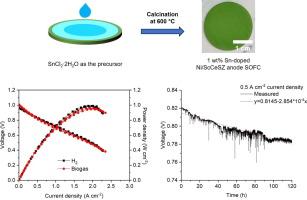模拟沼气操作下Sn, Ag, Cu, fe掺杂Ni/ScCeSZ阳极固体氧化物燃料电池的电化学性能和积碳行为评价
IF 13.2
1区 工程技术
Q1 ENGINEERING, CHEMICAL
引用次数: 0
摘要
研究了Sn、Ag、Cu和Fe掺杂剂在Ni/ScCeSZ阳极的渗透,以增强其甲烷干重整的催化活性,并提高Ni基阳极固体氧化物燃料电池(SOFCs)的抗碳性能。在750 °C的氢气和模拟沼气条件下,对改性SOFCs的电化学性能进行了评价。在所有测试的电池中,掺锡电池的输出功率最高,峰值功率密度分别为0.997 W•cm−2和0.963 W•cm−2。由于严重的碳沉积,未掺杂的Ni/ScCeSZ阳极在750 °C的沼气中暴露11 h后停止工作。相比之下,所有掺杂的细胞在模拟沼气下成功运行超过120 h。SEM和拉曼光谱表征证实,在沼气操作过程中,Sn、Ag和cu掺杂阳极表面没有碳沉积。尽管在沼气操作后,在未掺杂和掺铁的阳极上都检测到碳沉积,但铁掺杂物的渗入导致沉积在沼气测试阳极表面的碳的石墨化程度降低。本文章由计算机程序翻译,如有差异,请以英文原文为准。

Evaluation of electrochemical performance and carbon deposition behaviour of Sn, Ag, Cu, Fe-doped Ni/ScCeSZ anode solid oxide fuel cells operated with simulated biogas
The infiltration of Sn, Ag, Cu, and Fe dopants into a Ni/ScCeSZ anode was investigated to enhance its catalytic activity towards methane dry reforming and improve the carbon resistance of Ni-based anode solid oxide fuel cells (SOFCs). The electrochemical performance of the modified SOFCs was evaluated under hydrogen and simulated biogas at 750 °C. Among all the tested cells, the Sn-doped cell exhibited the highest power output, with peak power densities of 0.997 W•cm−2 and 0.963 W•cm−2, respectively. The undoped Ni/ScCeSZ anode ceased operation after 11 h of exposure to biogas at 750 °C due to severe carbon deposition. In contrast, all doped cells operated successfully for over 120 h under simulated biogas. SEM and Raman spectroscopy characterisation confirmed that no carbon deposition occurred on the surfaces of the Sn, Ag, and Cu-doped anodes during biogas operation. Despite carbon deposition being detected on both undoped and Fe-doped anodes after biogas operation, the infiltration of the Fe dopant resulted in a reduced degree of graphitisation of the carbon deposited on the biogas-tested anode surface.
求助全文
通过发布文献求助,成功后即可免费获取论文全文。
去求助
来源期刊

Chemical Engineering Journal
工程技术-工程:化工
CiteScore
21.70
自引率
9.30%
发文量
6781
审稿时长
2.4 months
期刊介绍:
The Chemical Engineering Journal is an international research journal that invites contributions of original and novel fundamental research. It aims to provide an international platform for presenting original fundamental research, interpretative reviews, and discussions on new developments in chemical engineering. The journal welcomes papers that describe novel theory and its practical application, as well as those that demonstrate the transfer of techniques from other disciplines. It also welcomes reports on carefully conducted experimental work that is soundly interpreted. The main focus of the journal is on original and rigorous research results that have broad significance. The Catalysis section within the Chemical Engineering Journal focuses specifically on Experimental and Theoretical studies in the fields of heterogeneous catalysis, molecular catalysis, and biocatalysis. These studies have industrial impact on various sectors such as chemicals, energy, materials, foods, healthcare, and environmental protection.
 求助内容:
求助内容: 应助结果提醒方式:
应助结果提醒方式:


